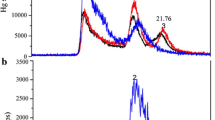Abstract
To elucidate the mechanism by which methylmercury (MeHg) is eliminated from organisms, male C57BL/6N mice were orally administered with MeHg chloride (5 mg/kg) and the chemical forms of its metabolites in plasma, urine and the kidney were determined by column chromatographic analysis. Orally administered MeHg rapidly entered the circulation, accumulated in the kidney and other tissues, and was slowly excreted in the urine. Ultrafiltration and gel filtration analysis revealed that most of plasma MeHg was accounted for by its albumin conjugate. Cell fractionation analysis revealed that about 80% of renal MeHg was recovered from the 15 000 g supernatant fraction of the kidney homogenate. If the kidney was homogenized in the presence of serine-borate complex, a potent inhibitor of γ-glutamyltranspeptidase (γ-GTP), about 50% of the MeHg in the supernatant fraction was recovered as its glutathione S-conjugate while the rest was bound to cytosolic protein(s). The major part of urinary MeHg was accounted for by its cysteine conjugate. However, urinary excretion of its glutathione conjugate increased significantly if animals were pretreated with acivicin, an affinity labeling reagent for γ-GTP. These and other results suggested that MeHg bound to albumin accumulated in the kidney predominantly via some non-filtrating peritubular mechanism, and localized in renal cytosolic compartment as its glutathione- and protein-bound forms. The glutathione S-conjugate of MeHg in the tubule cells might be transferred to the lumenal space, hydrolyzed to the cysteine S-conjugate, and then excreted in urine. These sequential events might constitute an important eliminatory pathway for a hazardous mercurial metabolite in mice.
Similar content being viewed by others
References
Bach RD, Weibel AT (1976) Nuclear magnetic resonance studies on anion-exchange reactions of alkylmercury mercaptides. J Am Chem Soc 98: 6241–6249
Baynes JW, Thorpe SR (1981) Identification of the sites of albumin catabolism in the rat. Arch Biochem Biophys 206: 372–379
Berlin M (1963) Renal uptake, excretion, and retention of mercury. II. A study in the rabbit during infusion of methyl- and phenylmercuric compounds. Arch Environ Health 6: 626–633
Carty AJ, Malone SF (1979) The chemistry of mercury in biological systems. In: Nriagu JO (ed) The biogeochemistry of mercury in the environment. Elsevier, Amsterdam, pp 433–479
Fitzpatrik DF, Welch LT, Landon EJ (1969) Characterization of plasma membrane proteins in mammalian kidney. J Biol Chem 244: 3570–3574
Hirata T, Takahashi H (1981) Degradation of methyl mercury glutathione by the pancreatic enzymes in bile. Toxicol Appl Pharmacol 58: 483–491
Hirayama K, Yasutake A (1986) Sex and age differences in mercury distribution and excretion in methylmercury-administered mice. J Toxicol Environ Health 18: 49–60
Hirayama K, Yasutake A, Inoue M (1987) Effect of sex hormone on the fate of methylmercury and glutathione metabolism in mice. Biochem Pharmacol 36: 1919–1924
Inoue M, Shinozuka S, Morino Y (1984) Functional coupling of enzymic processing and membrane transport of glutathione and related compounds in the kidney. Sulfur Amino Acids 7: 321–331
Jacobs MB, Yamaguchi S, Goldwater LJ, Gilbert H (1960) Determination of mercury in blood. Am Ind Hyg Assoc J 21: 475–480
Komsta-Szumska E, Reuhl KR, Miller DR (1983) Effect of selenium on distribution, demethylation, and excretion of methylmercury by the guinea pig. J Toxicol Environ Health 12: 775–785
Kostyniak PJ (1980) Differences in elimination rates of methylmercury between two genetic variant strains of mice. Toxicol Lett 6: 405–410
Lash LH, Jones DP (1985) Distribution of oxidized and reduced forms of glutathione and cysteine in rat plasma. Arch Biochem Biophys 240: 583–592
Miettinen JK, Rahola T, Hattula T, Rissanen K, Tillander M (1971) Elimination of 203Hg-methylmercury in man. Ann Clin Res 3: 116–122
Naganuma A, Imura N (1979) Methylmercury binds to a low molecular weight substance in rabbit and human erythrocytes. Toxicol Appl Pharmacol 47: 613–616
Naganuma A, Koyama Y, Imura N (1980) Behavior of methylmercury in mammalian erythrocytes. Toxicol Appl Pharmacol 54: 405–410
Naganuma A, Oda-Urano N, Tanaka T, Imura N (1988) Possible role of hepatic glutathione in transport of methylmercury into mouse kidney. Biochem Pharmacol 37: 291–296
Norseth T, Clarkson TW (1970) Studies on the biotransformation of 203Hg-labeled methylmercury chloride in rats. Arch Environ Health 21: 717–727
Norseth T, Clarkson TW (1971) Intestinal transport of 203Hg-labeled methyl mercury chloride. Role of biotransformation in rats. Arch Environ Health 22: 568–577
Orlowski M, Meister A (1963) γ-Glutamyl-p-nitroanilide: A new convenient substrate for determination and study of L- and D-γ-glutamyltranspeptidase activities. Biochim Biophys Acta 73: 679–681
Refsvik T, Norseth T (1975) Methyl mercuric compounds in rat bile. Acta Pharmacol Toxicol 36: 67–78
Schwarzenbach G, Schellenberg M (1965) Die Komplexchemie des Methylquecksilber-Kations. Helv Chim Acta 48: 28–46
Simpson RB (1961) Association constants of methylmercury with sulfhydryl and other bases. J Am Chem Soc 83: 4711–4717
Suzuki T, Miyata T, Katsunuma H (1971) Comparison of mercury contents in maternal blood, umbilical cord and placental tissues. Bull Environ Contamin Toxicol 5: 502–508
Thomas DJ, Smith JC (1979) Partial characterization of a low-molecular weight methylmercury complex in rat cerebrum. Toxicol Appl Pharmacol 47: 547–556
Tietze F (1969) Enzymic method for quantitative determination of nanogram amounts of total and oxidized glutathione: Applications to mammalian blood and other tissues. Anal Biochem 27: 502–522
Toyooka T, Imai K (1983) High-performance liquid chromatography and fluorometric detection of biologically important thiols, derivatized with ammonium 7-fluorobenzo-2-oxa-1,3-diazole-4-sulphonate (SBD-F). J Chromatogr 282: 495–500
Yasutake A, Hirayama K (1986) Strain difference in mercury excretion in methylmercury-treated mice. Arch Toxicol 59: 99–102
Author information
Authors and Affiliations
Rights and permissions
About this article
Cite this article
Yasutake, A., Hirayama, K. & Inoue, M. Mechanism of urinary excretion of methylmercury in mice. Arch Toxicol 63, 479–483 (1989). https://doi.org/10.1007/BF00316452
Issue Date:
DOI: https://doi.org/10.1007/BF00316452




